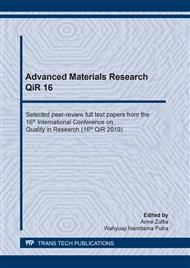[1]
A. Padhi, K. Nanjundaswamy, J. Goodenough, Phospho-olivines as Positive-Electrode Materials for Rechargeable Lithium Batteries, J. Electrochem. Soc. 144 (1997) 1188–1194.
DOI: 10.1149/1.1837571
Google Scholar
[2]
S. Li, Z. Su, A. Muslim, X. Jiang, X. Wang, Preparation and electrochemical properties of LiMn1-xFexPO4/C composite cathode materials for lithium ion batteries. Ceramics International, 41(9) (2015) 11132-11135.
DOI: 10.1016/j.ceramint.2015.05.061
Google Scholar
[3]
N. Nitta, F. Wu, J. T. Lee, G. Yushin, Li-ion battery materials: present and future, Mater. Today, 18(5) (2015) 252-264.
DOI: 10.1016/j.mattod.2014.10.040
Google Scholar
[4]
S. C. Yamada, S. C. Chung, K. Hinokuma, Optimized LiFePO4 for Lithium Battery Cathodes, J. Electrochem. Soc. 148 (3) (2001) A224.
DOI: 10.1149/1.1348257
Google Scholar
[5]
D. Choi, D. Wang, I-T. Bae, J. Xiao, Z. Nie, W. Wang, V. V. Viswanathan, Y. J. Lee, J-G. Zhang, G. L. Graff, Z. Yang, J. Liu, LiMnPO4 Nanoplate Grown via Solid-State Reaction in Molten Hydrocarbon for Li-Ion Battery Cathode, Nano Lett. 10 (8) (2010) 2799-2805.
DOI: 10.1021/nl1007085
Google Scholar
[6]
D. Linden, T. B. Reddy, Handbook of Batteries 3 Ed., The McGraw-Hills, New York, (2002).
Google Scholar
[7]
J. Cho, Y‐W. Kim, B. Kim, J‐G. Lee, B. Park, A Breakthrough in the Safety of Lithium Secondary Batteries by Coating the Cathode Material with AlPO4 Nanoparticles, Angew. Chem. Int. Ed. 42 (14) (2003) 1618-1621.
DOI: 10.1002/anie.200250452
Google Scholar
[8]
T. Kim, D. Kim, H. Ryu, J. Moon, J. Lee, S. Boo, J. Kim, Synthesis of lithium manganese phosphate nanoparticle and its properties. J. Phys. Chem. Solids 68 (2007) 1203–1206.
DOI: 10.1016/j.jpcs.2007.03.027
Google Scholar
[9]
L. Wu, S. Zhong, F. Lv, J. Liu, Improving the electrochemical performance of LiMnPO4/C by liquid nitrogen quenching. Mater. Lett. 110 (2013) 38–41.
DOI: 10.1016/j.matlet.2013.07.112
Google Scholar
[10]
N. Sofyan, D. Y. Putro, A. Zulfia, Performance of Vanadium-doped LiFePO4/C Used as a Cathode for a Lithium Ion Battery. Int. J. Technol. 8 (2016) 1307-1315.
DOI: 10.14716/ijtech.v7i8.6893
Google Scholar
[11]
L. Damen, F. D. Giorgio, S, Monaco, F. Veronesi, M. Mastragostino, Synthesis and characterization of carbon-coated LiMnPO4 and LiMn1-xFexPO4 (x = 0.2, 0.3) materials for lithium-ion batteries. J. Power Sources 218 (2012) 250-253.
DOI: 10.1016/j.jpowsour.2012.06.090
Google Scholar
[12]
J. Chen, Recent Progress in Advanced Materials for Lithium Ion Batteries, Materials 6 (2013) 156-183.
Google Scholar
[13]
K. S. Hougaard and L. Campagnolo, Reproductive Toxicity, in Adverse Effects of Engineered Nanomaterials, Elsevier Inc, Netherland, (2012).
DOI: 10.1016/b978-0-12-386940-1.00013-1
Google Scholar
[14]
F. Rodriguez-Reinoso, J. Silvestre-Albero, Activated Carbon and Adsorption, in Encyclopedia of Materials Science and Technology 2nd Ed., Elsevier Inc, 2001, pp.22-34.
Google Scholar
[15]
B. Marinho , M. Ghislandi, E. Tkalya, C. E. Koning, G. With, Electrical conductivity of compacts of graphene, multi-wall carbon nanotubes, carbon black, and graphite powder. J. Powder Technol. 221 (2012) 351–358.
DOI: 10.1016/j.powtec.2012.01.024
Google Scholar
[16]
H. Misak, S. Mall, Electrical conductivity, strength and microstructure of carbon nanotube multi-yarns. Materials and Design 75 (2015) 76–84.
DOI: 10.1016/j.matdes.2015.03.020
Google Scholar
[17]
N. Sofyan, A. D. Rachmawati, A. Zulfia, A. Subhan, Pyrolysis of activated carbon from coconut shell and its characteristic in the LiFePO4/V/C composite for lithium ion battery cathode, IOP Conf. Ser.: Earth Environ. Sci. 105 (2018) 012017.
DOI: 10.1088/1755-1315/105/1/012017
Google Scholar
[18]
S. P. Ong, L. Wang, B. Kang, G. Ceder, Li-Fe-P-O2 Phase Diagram from First Principles Calculations, Chem. Mater. 20 (2008) 1798–1807.
DOI: 10.1021/cm702327g
Google Scholar
[19]
B. Ding, P. Xiao, G. Ji, Y. Ma, L. Lu, J. Y. Lee, High-Performance Lithium-Ion Cathode LiMn0.7Fe0.3PO4/C and the Mechanism of Performance Enhancements through Fe Substitution, ACS App. Mater. Interfaces, 5 (2013) 12120−12126.
DOI: 10.1021/am403991f
Google Scholar
[20]
D. Wu, Q. Lv, S. Feng, J. Chen, Y. Chen, Polylactide composite foams containing carbon nanotubes and carbon black: Synergistic effect of filler on electrical conductivity, Carbon, 95(2015) 380-387.
DOI: 10.1016/j.carbon.2015.08.062
Google Scholar
[21]
L. Kavan, R. Bacsa, M. Tunckol, P. Serp, S. M. Zakeeruddin, F. L. Formal, Marketa Zukalova and M. Graetzel, Multi-walled carbon nanotubes functionalized by carboxylic groups: Activation of TiO2 (anatase) and phosphate olivines (LiMnPO4; LiFePO4) for electrochemical Li-storage, J. Power Sources, 195 (2010) 5360–5369.
DOI: 10.1016/j.jpowsour.2010.03.028
Google Scholar


